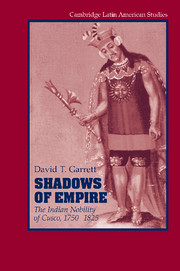Book contents
- Frontmatter
- Contents
- List of Illustrations
- Acknowledgments
- Pueblos Mentioned in Text
- Pueblos on Maps, by Province
- Introduction
- Part I INDIAN ELITES AND THE COLONIAL ORDER
- Part II THE INDIAN NOBILITY OF BOURBON CUSCO
- Part III CRISIS AND COLLAPSE
- 6 From Reform to Rebellion
- 7 The Breakdown of the Colonial Order
- Conclusion
- Appendix
- Glossary
- Bibliography
- Index
6 - From Reform to Rebellion
Published online by Cambridge University Press: 19 October 2009
- Frontmatter
- Contents
- List of Illustrations
- Acknowledgments
- Pueblos Mentioned in Text
- Pueblos on Maps, by Province
- Introduction
- Part I INDIAN ELITES AND THE COLONIAL ORDER
- Part II THE INDIAN NOBILITY OF BOURBON CUSCO
- Part III CRISIS AND COLLAPSE
- 6 From Reform to Rebellion
- 7 The Breakdown of the Colonial Order
- Conclusion
- Appendix
- Glossary
- Bibliography
- Index
Summary
On November 4, 1780, Don Jose Gabriel Tupac Amaru seized Don Antonio de Arriaga, Tinta's corregidor, as he passed through Tungasuca, of which Tupac Amaru was cacique. For the next six days Tupac Amaru imprisoned Arriaga, while a huge crowd assembled in the pueblo; proclamations were read denouncing Arriaga and claiming that “[t]hrough the King it has been ordered that there no longer be sales tax, customs, or the Potosí mita and that Don Antonio Arriaga lose his life because of his harmful behavior.” Tupac Amaru forced the corregidor to send for weapons and money so that the cacique and his followers were well armed; then, on November 10, Arriaga was hung in front of the crowd. Tupac Amaru and his troops headed north down the Vilcanota valley, reaching Quiquijana in two days and sacking the obraje of Pomacanchis on their way. Caciques from nearby pueblos actively joined, or were caught up in, the rebellion, and the forces grew dramatically as they went. The upper Vilcanota was in open rebellion.
Receiving news of Arriaga's execution on November 12, the Cusco cabildo sent a regiment to quash the rebellion. At the forefront were Cusco's Inca nobles, who rejected Tupac Amaru almost to a one; so too would their peers around Titicaca. Indeed, the irony of Inca (and other Indian noble) loyalty to the crown is striking, and this chapter attempts to explain it. That loyalty was not for want of appeals from Tupac Amaru: as he marched down the Vilcanota he sent letters – alternately cajoling and threatening – to leading Inca nobles and highland caciques asking them to join him.
- Type
- Chapter
- Information
- Shadows of EmpireThe Indian Nobility of Cusco, 1750–1825, pp. 183 - 210Publisher: Cambridge University PressPrint publication year: 2005

